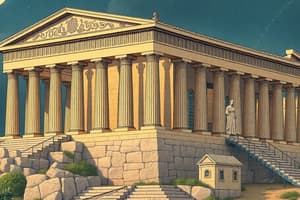Podcast
Questions and Answers
When was the Propylaea built?
When was the Propylaea built?
- 500 BCE
- 410 BCE
- 437 to 432 BCE (correct)
- 450 to 460 BCE
What is the meaning of the word 'Acropolis'?
What is the meaning of the word 'Acropolis'?
- High city (correct)
- City by the sea
- City on an island
- Low city
When was the Temple of Athena-Nike built?
When was the Temple of Athena-Nike built?
- Between 427 to 424 BCE (correct)
- Around 421 to 405 BCE
- Around 350 BCE
- Between 448 to 432 BCE
What were the financial constraints that delayed the completion of the Propylaea?
What were the financial constraints that delayed the completion of the Propylaea?
What does the name 'Erechtheion' refer to?
What does the name 'Erechtheion' refer to?
Who was the designer of the Erechtheion?
Who was the designer of the Erechtheion?
Who was the sculptor of the 12-meter-high statue of Athena in the Parthenon?
Who was the sculptor of the 12-meter-high statue of Athena in the Parthenon?
Which event led to the damage of the entire Parthenon structure?
Which event led to the damage of the entire Parthenon structure?
What material was used for the construction of the Parthenon?
What material was used for the construction of the Parthenon?
Who is credited as the supervisor of the construction of the Parthenon?
Who is credited as the supervisor of the construction of the Parthenon?
What is the significance of the south porch of the Erechtheion?
What is the significance of the south porch of the Erechtheion?
What was the Erechtheion divided into?
What was the Erechtheion divided into?
What type of columns were used in the Parthenon?
What type of columns were used in the Parthenon?
What was the function of Temple of Athena-Nike?
What was the function of Temple of Athena-Nike?
Who designed the Theater of Epidaurus?
Who designed the Theater of Epidaurus?
Flashcards are hidden until you start studying
Study Notes
Acropolis and Its Structures
- The word 'Acropolis' means "high city" in Greek, referring to the citadel located on a high rocky outcrop above the city of Athens.
Propylaea
- The Propylaea was built, but its completion was delayed due to financial constraints.
- The exact date of its construction is not specified.
Temple of Athena-Nike
- The Temple of Athena-Nike was built, but the exact date is not specified.
- Its function was to serve as a temple, likely dedicated to the goddess Athena.
Erechtheion
- The name 'Erechtheion' refers to the mythological king Erechtheus, who was worshipped in ancient Athens.
- The Erechtheion was designed by the architect Mnesikles.
- The significance of the south porch of the Erechtheion lies in its featuring six majestic Ionic columns, known as the Caryatids, which are sculpted female figures serving as column supports.
- The Erechtheion was divided into two main parts: the north wing, dedicated to the worship of Athena, and the south wing, dedicated to the worship of Poseidon.
Parthenon
- The Parthenon was constructed using Pentelic marble and limestone.
- The type of columns used in the Parthenon were Doric columns.
- The Parthenon housed a massive 12-meter-high statue of Athena, sculpted by Phidias.
- The supervisor of the Parthenon's construction was Pericles, an Athenian statesman.
- The entire Parthenon structure was damaged in an event, likely a fire, in 1687.
Other Structures
- The Theater of Epidaurus was designed by Polykleitos the Younger.
Studying That Suits You
Use AI to generate personalized quizzes and flashcards to suit your learning preferences.




